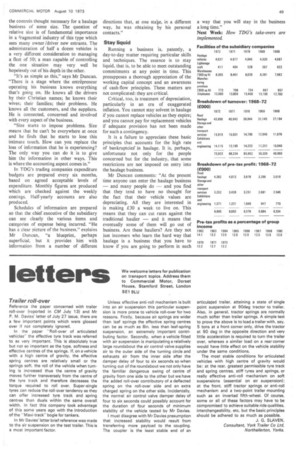letters
Page 51

If you've noticed an error in this article please click here to report it so we can fix it.
Trailer roll-over
Reference the paper concerned with trailer roll-over (reported in CM July 13) and Mr P. M. Davies' letter of July 27 issue, there are a few important points which were glossed over if not completely ignored.
In the paper "Roll-over of articulated vehicles" the effective tyre track was referred to as very important. This is absolutely true but not so important as the type, softness and effective centres of the springs. If, on a vehicle with a high centre of gravity, the effective spring centres are relatively small or the springs soft, the roll of the vehicle when turning is increased thus the centre of gravity moves further transversely from the centre of the tyre track and therefore decreases the torque required to roll over. Super-single tyres can reduce the roll-over tendency as they can offer increased tyre track and spring centres than duals within the same overall width. In fact this company took advantage of this some years ago with the introduction of the "Maxi-track" bogie for tankers.
In Mr Davies' letter brief reference was made to the air suspension on the test trailer. This is a most important factor. Unless effective anti-roll mechanism is built into an air suspension this particular suspension is more prone to vehicle roll-over for two reasons. Firstly, because air springs are wider than leaf springs the effective spring centres can be as much as 8in. less than leaf-spring suspension, an extremely important contributing factor. Secondly, when a vehicle fitted with air suspension is manipulating a relatively large roundabout the air control valve supplies air to the outer side of the turning circle and exhausts air from the inner side after the damper delay of four to six seconds so when turning out of the roundabout we not only have the familiar dangerous swing of centre of gravity from one side to the other but we have the added roll-over contributory of a deflected spring on the roll-over side and an extra charged spring on the other side. Incidentally, the normal air control valve damper delay of four to six seconds could possibly account for the duration of four seconds of minimum stability of the vehicle tested by Mr Davies.
I must disagree with Mr Davies presumption that increased stability would result from transferring more payload to the coupling. The coupler is the least stable end of an articulated trailer, attaining a state of single point suspension at 90deg tractor to trailer. Also, in general, tractor springs are normally much softer than trailer springs. A simple test to prove the above is to load a trailer with, say, 5 tons at a front corner only, drive the tractor at 90 deg in the opposite direction and very little acceleration is required to turn the trailer over, whereas a similar load on a rear corner would have little effect on the vehicle stability under the same conditions.
The most stable conditions for articulated vehicles with high centre of gravity would be: at the rear, greatest permissible tyre track and spring centres, stiff tyres and springs, or really effective anti-roll mechanism on soft suspensions (essential on air suspension); at the front, stiff tractor springs or anti-roll mechanism and a two-point trailer mounting such as an inverted fifth-wheel. Of course, some or all of these factors may have to be compromised to achieve suitable ride qualities, interchangeability, etc. but the basic principles should be adhered to as much as possible. J. G. SLAVEN, Consultant, York Trailer Co Ltd, Northallerton, Yorks.




























































































